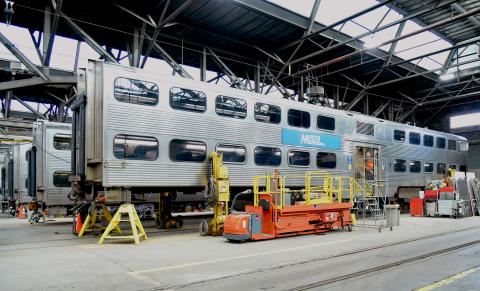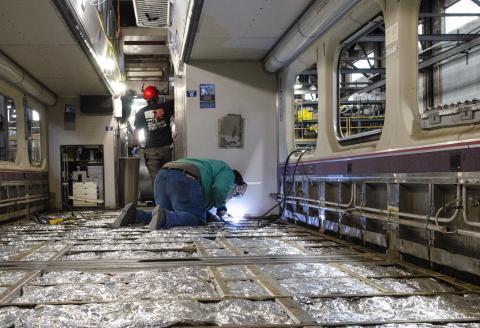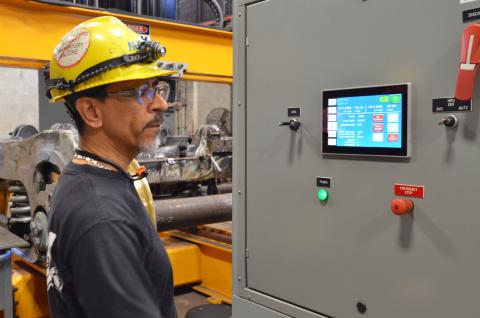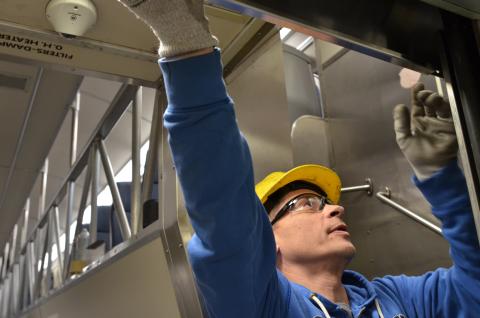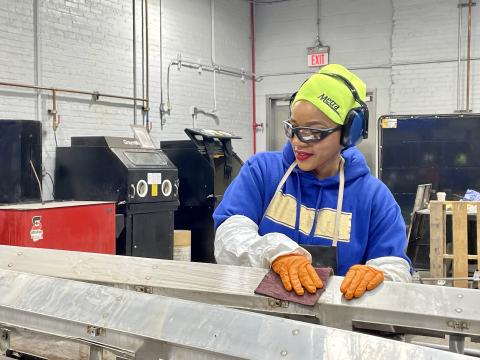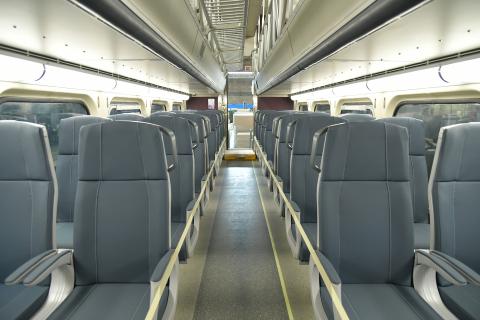Wedged between the Dan Ryan Expressway and Chicago’s Bronzeville neighborhood sits Metra’s 47th/49th Street Yard. To the casual observer, the yard is the daily servicing site for the equipment used to operate our Rock Island Line to Joliet. But in a little more than a decade, it has also become home to Metra’s successful in-house railcar rehab program.
Since 2010, more than 373 passenger railcars have been overhauled at the 49th Street Car Shop. These overhauls extend the life of Metra’s passenger railcars by 10 to 15 years. Keeping the program in-house versus outsourcing has been a win-win for the agency – reducing costs, providing better quality control, and keeping skilled jobs in Chicago and northeast Illinois.
“The talent in this shop is unbelievable,” says Rich Keating, director, Mechanical Capital Projects. “We all bought into the program – it’s quicker, better quality and we all work together. That work looks easy due to the hard work, unparalleled talent and dedication each Metra employee brings with them every day.”
Flipping a rail car is no easy task, but it’s a welcome challenge for Metra’s overhaul team, composed of men and women working as carmen, electricians, sheet metal workers, laborers, coach cleaners, and foremen. From demolition day to getting the railcar back in service, it takes these railroad heroes only 24 working days per car.
The rehab process is essentially a four-step assembly line. At Workstation A, the demo team works their way through the car’s interior, removing windows, doors, seats, bathrooms, flooring, and lighting. A team of electricians works simultaneously on the undercarriage, removing and replacing the cables that supply power from the locomotives to light and heat the cars. New flooring and windows are installed and it’s off to the next workstation.
Jessica Martin, a carman, has been with Metra for 8 years and this job provides a good living for her and her family. “I do the floors – take them out, put them back in,” she said. “I started railroading at 20, and it’s been 15 years of railroading (for me). I’m a single mom so I can support my kids with this job. I bought a house, too.”
When the car arrives at Workstation B, another team of carmen and electricians start by removing and replacing most of the car’s mechanical elements. First, the AC units above the vestibule are removed and sent to Metra’s in-house AC rebuild shop. Then, the car’s wheel trucks are removed and sent to Metra’s truck shop for rebuild. Both the AC and wheel shops are also inside the 49th Street facility.
The carmen then focus on the car’s undercarriage, removing and replacing wheelchair lifts, waste retention tanks for the onboard bathrooms, and the coupling systems at each end of the car. Inside the car, a team of electricians gets busy changing the electrical panels that control the doors and the AC. They also replace all interior heating elements and install new LED lighting and electrical outlets. The rehab is the perfect opportunity to upgrade technology, and this team uses it to install or upgrade components of Metra’s new train-tracking system as well as onboard cameras for customer safety.
On Day 5, the newly restored wheel trucks return from the shop and are reinstalled and tested to ensure everything is leveled. The next day (Day 6) the team reinstalls the AC units and completes testing of all the newly installed electrical and mechanical components before sending the car to the next workstation.
“We pretty much take the cars and make them new again,” said Marlon D. Wilson, 15-year veteran electrician. “We break it down to the lowest level and bring it back to the highest pristine level that we can get, so with that comes rewiring, modifications, cleaning, you name it, whatever it takes to get it from what it looked like before to showroom-new.”
Now, it’s time for the railcar to move to Workstation C, where another team installs new seats and reassembles the vestibule. The team also rebuilds the onboard lavatory, adding new walls, new doors, new flooring, sink and toilet.
“I believe (this rehab project) is very important – it keeps us working,” said Enrique Flores, a sheet metal worker who’s been at Metra for 7 years. “We are a service industry, so it’s very important to have happy customers to stay in business. I install the lavatories, the toilets, so that really impacts the customers if they’re taking a two-hour ride. (Laughs) You know, it’s a convenience if you’re on the train – you can’t just jump off and use the bathroom.”
The railcar then moves to the final stage of the rehab process at Workstation D, where two carmen and two electricians go through the railcar again, putting the final touches and testing the mechanical components, including timing on the entry doors, the electrical systems, the AC units, lighting, and public address system. When everything gets the green light, the coach cleaners come in to clean and disinfect the car, preparing it for final inspection. Once the inspectors and managers have determined that the car meets all safety regulations and has passed inspection, it is approved to go back into service.
“I’m a coach cleaner,” said Eddie Jasson, who has been with Metra for 9 months. “I’m in charge of making sure all the cars are clean and the parts are washed to make them look like new again. Cleaning is extremely important. The first thing you wanna see when you get on the train is how clean it is and how presentable it looks, so obviously it’s very important to have a clean train (for our customers).”
The employees working on this project agree that keeping this work in-house isn’t just a money-saving move for Metra. It’s created a highly skilled workforce who take pride in working as a team to ensure that the outcome is a quality product. It’s also created a work environment where both union and management employees exchange ideas and work together to improve the process.
Lamont Jones, a Metra carman with 12 years of experience, says having the rehab team in-house means that everyone looks after each other and is invested in quality control.
“You know exactly once this car gets to our station what we’re looking for, what should be there and what shouldn’t be there, so it makes everything really smooth having them at the next track over,” Jones said. “I think we are going above and beyond with the challenges that have been set before us.”
“From the director on down, it’s basically like an open-door policy,” said Marlon D. Wilson, an electrician who’s worked at Metra for 15 years. “If you choose to go in there and voice your opinion, you feel like there is something you need help with, they do.”
The result is a dedicated team who rely on each other and take pride in safely producing quality work. To date, Metra’s railcar rebab program has added nearly 80 skilled jobs and saved the agency $130 million versus sending the work to an offsite vendor.
